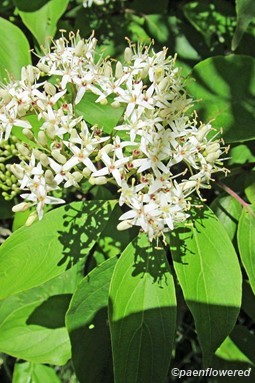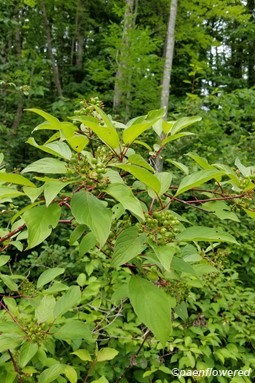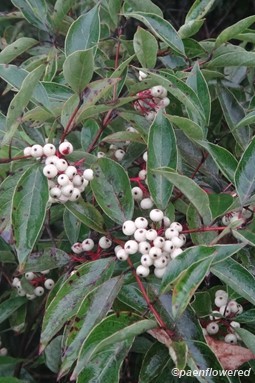Cornus sericea
Bright red-stemmed dogwood with white berries
Cornus sericea red osier
Add to MyPlants View Locations
This perennial shrub or small tree is a source of color almost all year round. It is easily identified by the red stems that turn particularly bright in the winter and contrast beautifully with a background of white snow. Sometimes this coloration is less distinct if the stems grow in the shade.
In spring the medium to dark green leaves emerge and grow 2-5 inches long. These are ovate or lance-shaped, and are opposite on the stem. The leaves have a silky texture and are pubescent on the underside. In May and June the shrub produces clusters of white fragrant flowers. These showy clusters are 2-3 inches in diameter. Individual flowers have 4 white petals and a green calyx. Each is only about 1/4 inch wide.
In mid-summer the flowers are replaced with clusters of white drupes (berries) that contain one large seed. These are edible but have a mildly sour or bitter taste. Birds commonly feed on these. In the fall the leaves turn various shades of red or orange and later fade to purple.
The red osier dogwood is also called the red twig dogwood. It is found throughout North America except for the deep South and southern Midwest. It grows in wet swampy areas, wetland margins and along shorelines. It is commonly planted as a colorful ornamental and to control erosion. Native Americans used the inner bark as a source of dye and as an additive to tobacco. The shallow spreading root system will sprout new stems to form colonies of the species. New trees can be grown from root cuttings.
Habitat & Range
Infrequent in swamps, moist fields, and thickets.
Scattered throughout the state.
Wetland code: FACW
Phenology
Flowers in May.
Fruits in July.
Characteristics
Fruit green when young, turns white at full maturity.
Plant Codes
S-rank: S5 (Secure)
G-rank: G5 (Secure)
Cornus sericea red osier
Synonyms: Cornus stolonifera, Swida sericeaAdd to MyPlants View Locations











Comments
Have you spotted this plant in your area? We'd love to hear about your experience! Share your comments or questions about the plant below. Comments are moderated before posting.